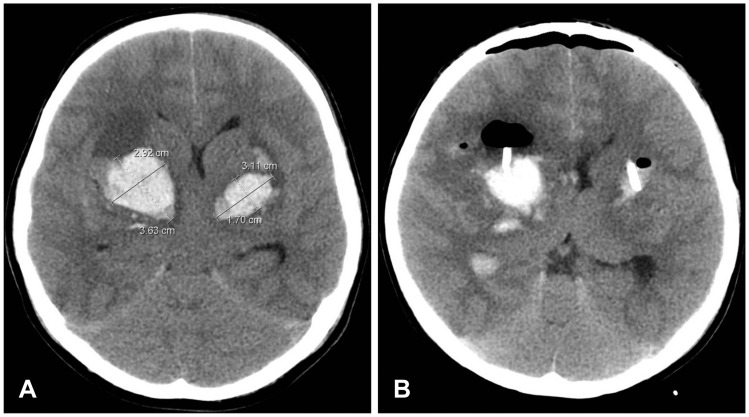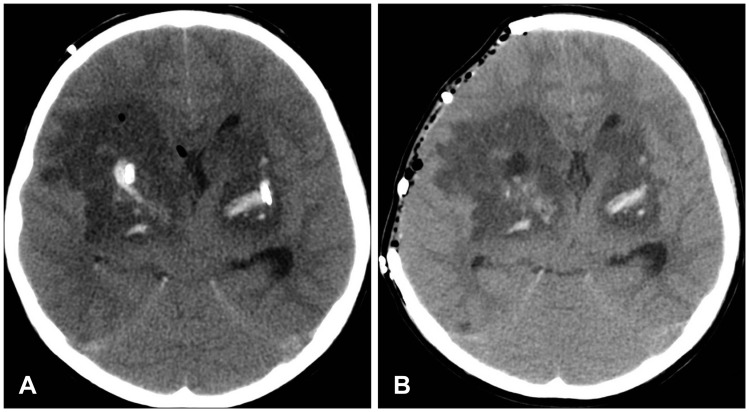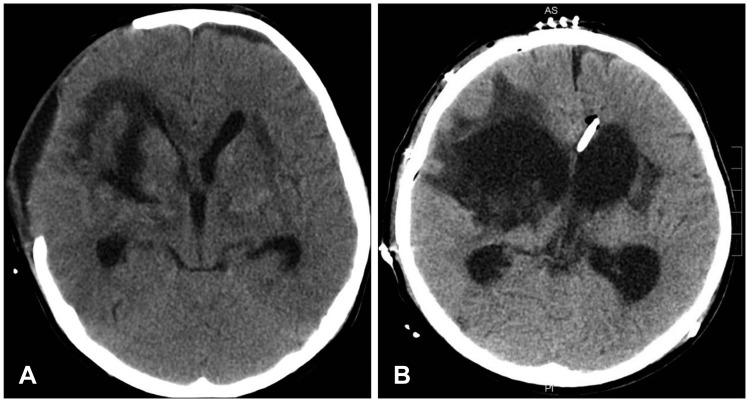Korean J Neurotrauma.
2016 Oct;12(2):148-151. 10.13004/kjnt.2016.12.2.148.
A Viewpoint on Treatment of Traumatic Bilateral Basal Ganglia Hemorrhage in a Child: Case Report
- Affiliations
-
- 1Department of Neurosurgery, Gyeongsang National University School of Medicine and Gyeonsang National University Hospital, Jinju, Korea. chl68@gnu.ac.kr
- KMID: 2356790
- DOI: http://doi.org/10.13004/kjnt.2016.12.2.148
Abstract
- Traumatic basal ganglia hemorrhage (TBGH) is a rare presentation of head injuries. Bilateral lesions are extremely rare. The pathophysiologic mechanism of bilateral TBGH seems to be the same as diffuse axonal injury. However, limited information about childhood bilateral TBGH is available in the literature. We report the case of a child with bilateral TBGH treated with stereotactic aspiration of hemorrhage and periodic urokinase irrigation.
Keyword
MeSH Terms
Figure
Reference
-
1. Figueroa BE, Keep RF, Betz AL, Hoff JT. Plasminogen activators potentiate thrombin-induced brain injury. Stroke. 1998; 29:1202–1207. discussion 1208. PMID: 9626295.
Article2. Kang JK, Park CK, Kim MC, Kim DS, Song JU. Traumatic isolated intracerebral hemorrhage in children. Childs Nerv Syst. 1989; 5:303–306. PMID: 2805000.
Article3. Katz DI, Alexander MP, Seliger GM, Bellas DN. Traumatic basal ganglia hemorrhage: clinicopathologic features and outcome. Neurology. 1989; 39:897–904. PMID: 2739917.
Article4. Mosberg WH, Lindenberg R. Traumatic hemorrhage from the anterior choroidal artery. J Neurosurg. 1959; 16:209–221. PMID: 13642112.
Article5. Narayan RK, Narayan TM, Katz DA, Kornblith PL, Murano G. Lysis of intracranial hematomas with urokinase in a rabbit model. J Neurosurg. 1985; 62:580–586. PMID: 3973729.
Article6. Öğrenci A, Ekşi MŞ, Gün B, Koban O. Traumatic basal ganglia hematoma following closed head injuries in children. Childs Nerv Syst. 2016; 32:1237–1243. PMID: 26994013.
Article7. Rohde V, Rohde I, Thiex R, Ince A, Jung A, Dückers G, et al. Fibrinolysis therapy achieved with tissue plasminogen activator and aspiration of the liquefied clot after experimental intracerebral hemorrhage: rapid reduction in hematoma volume but intensification of delayed edema formation. J Neurosurg. 2002; 97:954–962. PMID: 12405387.
Article8. Seo DH. Protracted perihematomal edema after fibrinolysis therapy with urokinase. Korean J Cerebrovasc Surg. 2003; 5:153–157.9. Sharma GV, Cella G, Parisi AF, Sasahara AA. Thrombolytic therapy. N Engl J Med. 1982; 306:1268–1276. PMID: 7040966.
Article10. Sobani ZA, Ali A. Pediatric traumatic putamenal strokes: Mechanisms and prognosis. Surg Neurol Int. 2011; 2:51. PMID: 21697966.
Article11. Vega MB, Hamamoto Filho PT, Machado Cde J, Zanini MA. Traumatic brain injury presenting with bilateral basal ganglia hemorrhage. Neurol Neurochir Pol. 2015; 49:456–459. PMID: 26652883.
Article
- Full Text Links
- Actions
-
Cited
- CITED
-
- Close
- Share
- Similar articles
-
- Traumatic Intracerebral Hemorrhage in Bilateral Basal Ganglia
- Bilateral Traumatic Hemorrhage of the Basal Ganglia
- Mirror-Image Intracerebral Hemorrhage in Basal Ganglia: Case Report
- Spontaneous Bilateral Basal Ganglia Hemorrhage: Case Report
- A Case of Bilateral Simultaneous Hypertensive Intracerebral Hemorrhage in Basal Ganglia




